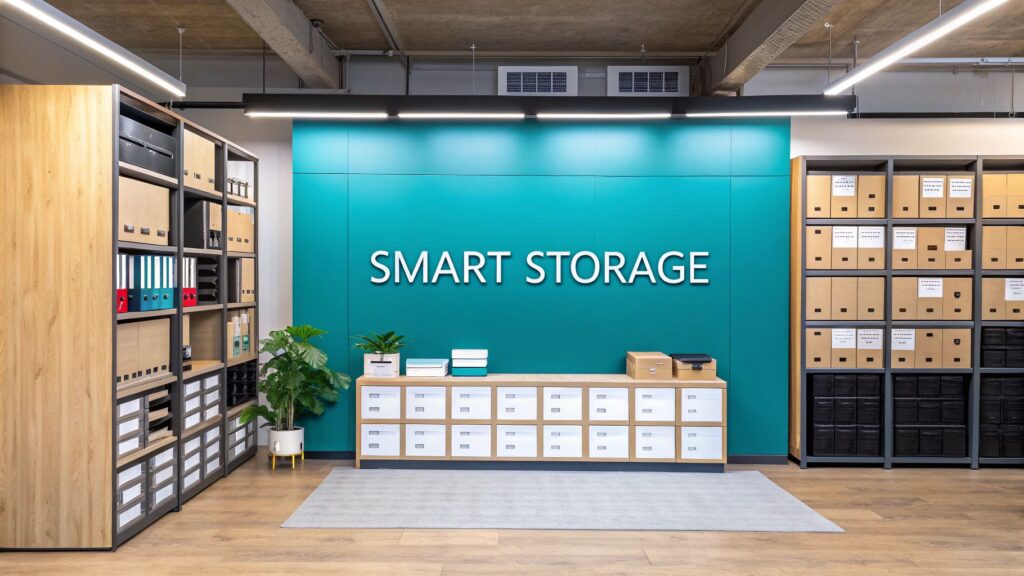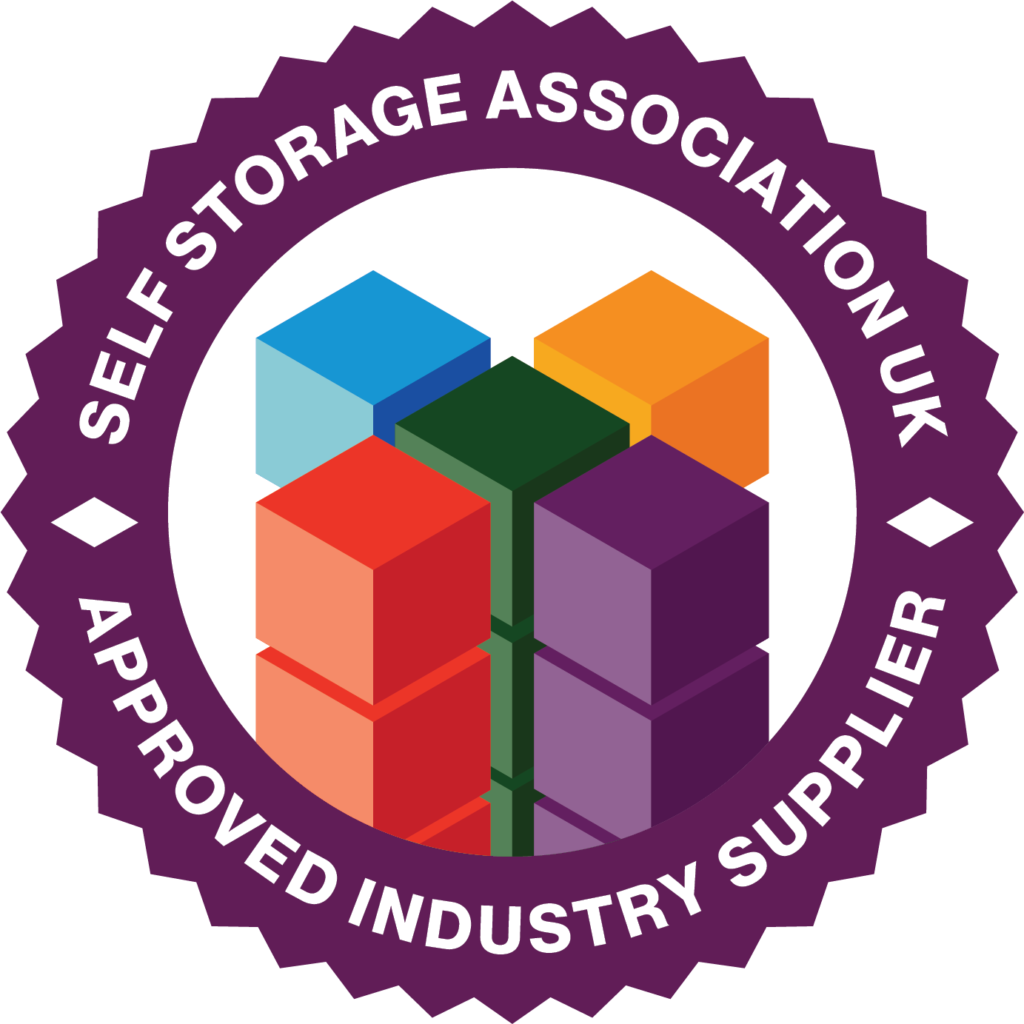Office storage units are essentially an extension of your workspace – a secure, off-site spot where you can keep physical assets like documents, furniture, stock, or equipment. Think of them as a flexible and affordable way to expand your company’s footprint, helping you de-clutter the main office, handle operational overflow, and make transitions like moving or downsizing a whole lot smoother.
Why Modern Offices Need Smarter Storage
The traditional office is changing fast. Those sprawling floors once packed with desks are being replaced by dynamic, multi-purpose hubs built for collaboration, not just permanent workstations. As businesses embrace flexible working and shrink their commercial footprints, the headache of managing physical stuff has become a real challenge. This is where modern office storage units have gone from a simple convenience to a vital strategic tool.
It’s no longer about stashing old files in a dusty room. Today, off-site storage gives you operational agility. It’s a practical fix for several common scenarios that UK businesses are navigating right now.
Common Drivers for Business Storage
The move towards smarter storage is all about real-world business needs. For instance, a growing number of city-based landlords are negotiating lease renewals that shrink office space by 20-35% as companies shift to hybrid models. While they’re using less square footage, businesses are investing more in high-quality solutions for the space they keep, which is fuelling demand for intelligent, efficient organisation. You can find more on this trend in the UK office furniture market over on Mordor Intelligence.
This shift creates a clear need for external support. To keep up, modern offices are turning to specialist services. You can also explore various storage solutions for businesses to get a better sense of what’s out there.
Here are a few key situations where businesses typically turn to storage:
- Office Relocation or Refurbishment: Storing furniture, IT gear, and documents securely during a move or renovation is the best way to prevent damage and keep disruption to a minimum.
- Downsizing for Hybrid Work: As more of the team works from home, companies can cut back on expensive office space by storing surplus desks, chairs, and filing cabinets.
- Inventory and Stock Management: E-commerce brands and retailers often use storage units as flexible, low-cost warehouses to manage stock, avoiding the commitment of a long-term commercial lease.
- Document Archiving: Freeing up prime office real estate by securely archiving financial records, legal papers, and client files that you’re required to hold onto.
- Seasonal Needs: Keeping promotional materials, event equipment, or seasonal decorations out of the way helps the main workspace stay organised and clutter-free.
Ultimately, using a dedicated storage solution isn't just an afterthought anymore. It's a proactive strategy for getting organised, securing valuable assets, and saving a significant amount of money. Have a look at our detailed guide on how our storage units for business can help you hit your operational goals.
Choosing the Right Size Storage Unit for Your Business
Picking the right size for your office storage unit is one of those decisions that can either save you money or cost you a bundle. It's a fine line. Guess wrong, and you could end up paying for a half-empty space or, worse, frantically trying to cram everything in only to realise you've run out of room.
The key is to move past vague labels like ‘small’ or ‘large’ and start thinking in real-world terms. For instance, a 25 sq ft unit is ideal for about 50 standard archive boxes. A 100 sq ft unit? That's big enough to hold the entire contents of a small office floor during a refurbishment. It’s all about visualising what can actually fit inside.
Auditing Your Office Assets
Before you even start looking at units, the first step is to get a handle on what you're actually storing. You need to conduct a thorough audit of every single item. This isn't just about furniture; it's about building a complete inventory to understand the true volume of your needs. A detailed list ensures nothing gets forgotten.
Here’s a simple checklist to get you started on everything you plan to put into storage:
- Document Archives: How many filing cabinets or archive boxes have you got? Count them up. Are they standard size?
- Office Furniture: Make a list of every desk, chair, cabinet, bookshelf, and meeting table. Don’t forget the reception area and break rooms.
- IT Equipment: Take stock of all computers, monitors, printers, servers, and other networking gear. These items are often bulky and need careful handling.
- Excess Stock or Inventory: If you’re in e-commerce or retail, you'll need to work out your stock volume by the pallet, box, or item count to figure out the floor space required.
- Seasonal or Event Materials: Don't overlook the marketing banners, exhibition stands, and seasonal decorations that only come out once in a while but take up a surprising amount of room.
Once you have this inventory, you can start to visualise the total volume and figure out what can be stacked versus what needs its own floor space.
Common Unit Sizes and Their Real-World Equivalents
To help you get a clearer picture, let's translate some common UK unit sizes into practical, business-focused examples. Measurements are usually in square feet (sq ft), but it’s always handy to know the square metre (sq m) equivalent too.
A common mistake is forgetting about height. Most storage units have high ceilings—often around 8 feet—which means you can effectively double your storage capacity with clever stacking. Good organisation is everything.
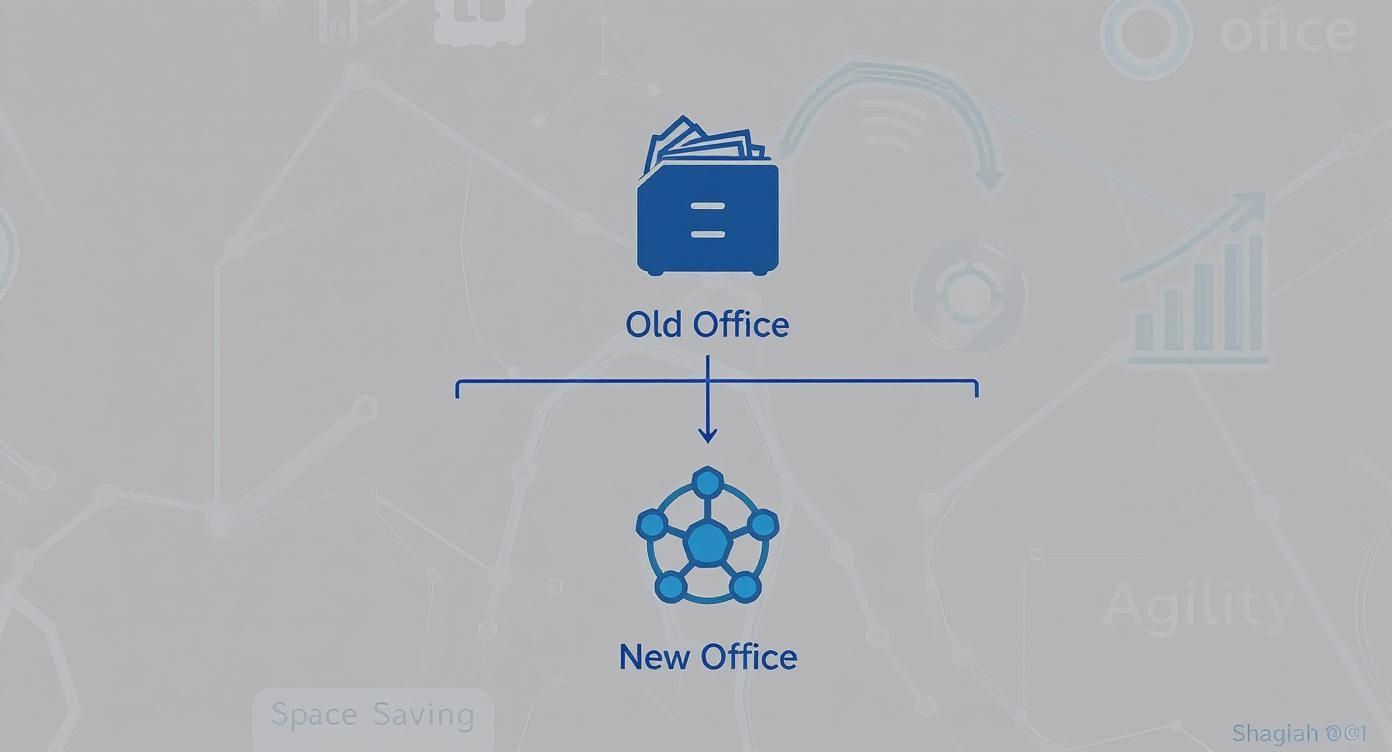
This infographic neatly shows how modern storage helps businesses shift from old-school, space-hungry setups to more agile models. By moving cumbersome archives and rarely used items off-site, companies can free up valuable office real estate for things that actually help the business grow.
To make this even easier, here’s a quick-reference table to help you match common unit sizes to typical office storage needs.
Common Business Storage Unit Sizes and Typical Uses
| Unit Size (Sq Ft) | Approx. Dimensions (Ft) | Equivalent To | Ideal For Storing |
|---|---|---|---|
| 25 sq ft | 5 x 5 | Large garden shed | 50-70 archive boxes, a small desk and chair, or spare computer monitors. |
| 50 sq ft | 5 x 10 | Large walk-in wardrobe | Contents of a small one-person office, including desk, chair, and filing cabinet. |
| 75 sq ft | 7.5 x 10 | Transit van | A few desks, multiple chairs, several filing cabinets, and office equipment. |
| 100 sq ft | 10 x 10 | Single garage | Furniture from a small office, excess stock on a few pallets, or marketing stands. |
| 150 sq ft | 10 x 15 | Large single garage | Contents of a medium-sized office floor or significant e-commerce inventory. |
This should give you a solid starting point for figuring out what you’ll need without overspending.
Finding Your Perfect Fit
Once your inventory is ready, you can start matching it to a unit size. It helps to group items based on how often you’ll need to access them. For instance, frequently needed stock should be kept near the front, while long-term document archives can be tucked away at the back.
Thinking about your layout beforehand can save you a lot of logistical headaches down the line. For a more detailed breakdown and some extra help choosing the perfect option, you can explore our complete guide on the size of storage units, which even includes a handy calculator. By taking a measured, organised approach, you can be confident you’re choosing a unit that’s just right for your business, both now and in the future.
What to Look for in a Business Storage Facility
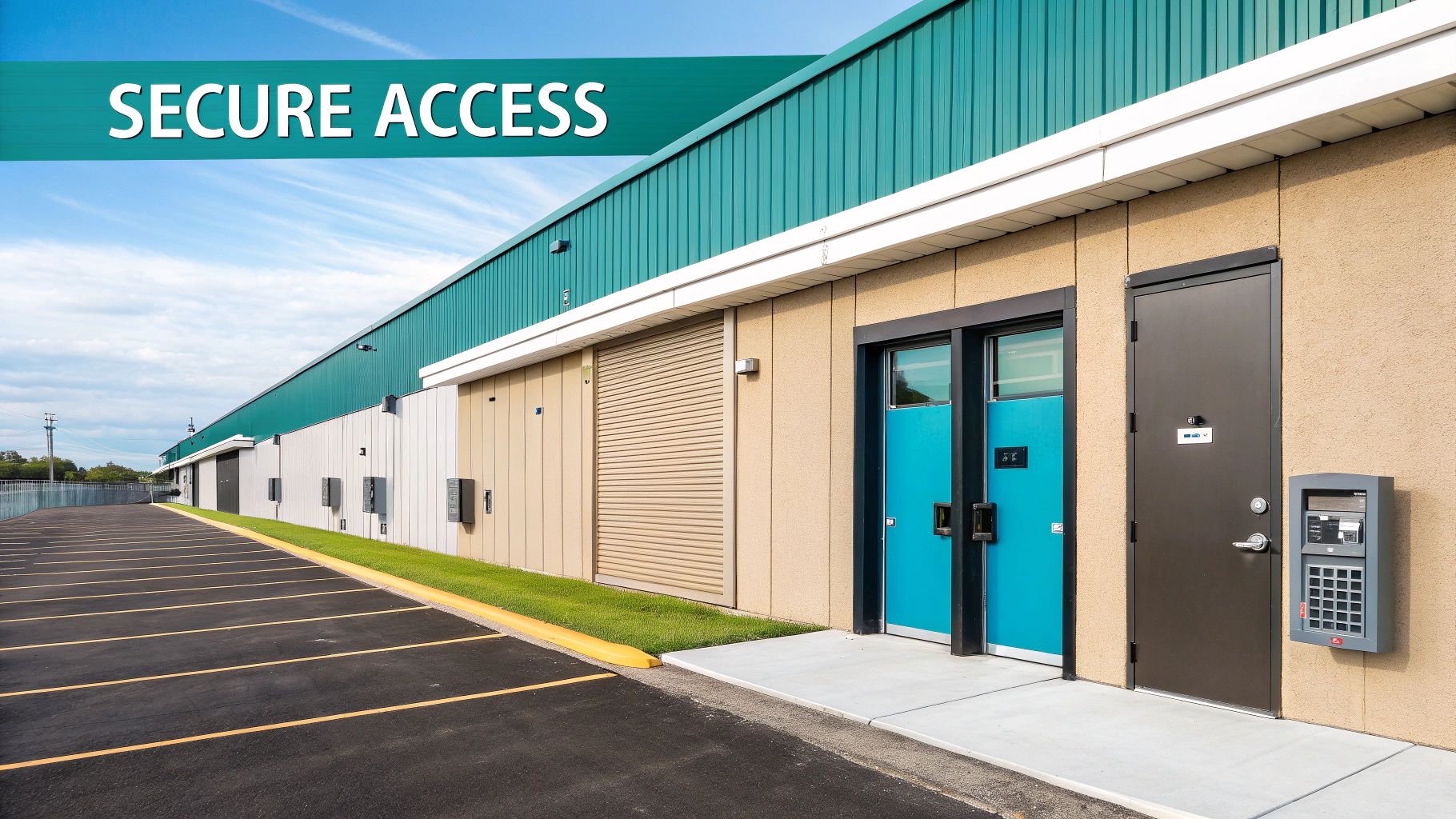
When you're entrusting your company's assets to a third party, it’s crucial to remember that not all storage facilities are created equal. Choosing the right one is about more than just finding enough square footage; it's about securing a reliable, safe, and accessible extension of your own office. The features on offer can be the difference between total peace of mind and a significant business risk.
Think of it like choosing a bank. You wouldn't leave your money in a vault with a flimsy door and no cameras, and the same logic applies to your physical assets. When you're looking at storage units for office use, things like top-notch security, environmental controls, and easy access are non-negotiable.
Robust Security Measures
The absolute foundation of any reputable business storage facility is its security. Your assets—whether that’s sensitive documents, expensive IT equipment, or valuable stock—demand serious protection from theft and unauthorised access. A simple padlock on the door just won't cut it.
The gold standard here is a multi-layered security approach, where several systems work together to create a secure fortress.
Look for these key security features:
- 24/7 Monitored CCTV: High-definition cameras should cover every key area, from entrances and exits to corridors and loading bays. The crucial part is that they are actively monitored, not just recording, to ensure a rapid response to anything suspicious.
- Secure Access Control: Modern facilities use electronic keypad entry or key fobs. This isn't just for convenience; it logs every single entry and exit, creating a clear audit trail of who was on-site and when.
- Individually Alarmed Units: While site-wide security is vital, the best protection comes with alarms on each individual unit. This gives you an immediate alert if your specific space is breached, adding a critical layer of personalised security.
- Perimeter Fencing and Lighting: A well-lit facility surrounded by secure perimeter fencing is a powerful deterrent. It makes the site a much harder target for any potential intruders from the get-go.
Climate-Controlled Units for Asset Protection
Many standard storage units are little more than metal boxes, leaving your belongings exposed to the UK's notoriously damp climate and fluctuating temperatures. For a lot of business assets, this can lead to irreversible damage from damp, mould, rust, and extreme temperature swings.
This is exactly where climate-controlled storage comes in. These units maintain a consistent temperature and humidity level all year round, creating a stable environment that’s perfect for sensitive items.
Think of a climate-controlled unit as a preservation chamber for your most valuable assets. It’s a small extra investment that can prevent the costly replacement of equipment or the loss of irreplaceable documents.
Items that absolutely need a climate-controlled environment include:
- Electronics and IT Equipment: Computers, servers, and other hardware contain delicate circuits that damp and condensation can easily ruin.
- Archived Documents: Paper records, books, and marketing materials can quickly degrade, warp, or grow mould in a humid space.
- Wooden or Upholstered Furniture: Your office desks, chairs, and reception furniture can swell, crack, or become mildewed without proper climate regulation.
- Pharmaceuticals or Sensitive Stock: Any inventory that needs stable conditions to maintain its quality and integrity requires this feature.
Unbeatable Accessibility and Convenience
Security and protection are paramount, but a storage unit is pretty useless if you can't get to it when you need to. Many businesses operate well outside the traditional 9-to-5, especially during an office move, a stocktake, or when preparing for an event. A facility with restrictive opening hours can seriously throw a spanner in the works.
That's why you should always look for a provider offering extended access hours—ideally from early morning to late at night, seven days a week. This flexibility means you can get to your items on your schedule, not someone else's.
On a practical note, consider the physical layout of the facility. Look for handy features like wide driveways that make it easy to manoeuvre a van, ample loading bays to avoid queues, and the availability of trolleys or dollies to help move heavy items safely. These small details make a huge difference, turning the process of using your storage units for office from a chore into a smooth, hassle-free experience.
Breaking Down the Costs of Office Storage in the UK
Figuring out the real cost of storage units for office use is key to getting your budget right. The monthly fee you see advertised isn't just a number plucked from thin air; it’s a calculation based on several factors that can really shift what you end up spending. Getting a clear picture of the pricing means you can compare quotes properly and avoid any nasty surprises later on.
The biggest things that will shape your monthly bill are the unit’s size and its location. It makes sense that a small 25 sq ft unit for archiving a few boxes of documents will be far cheaper than a huge 150 sq ft space needed to hold an entire office’s worth of furniture during a refit. In the same way, a storage facility in a prime spot like central London or Manchester will naturally have higher rates than one out in the suburbs, where land is less of a premium.
Don’t forget about specialised features, either. For example, climate-controlled units—which are a must for protecting sensitive electronics or important paperwork from damp—usually cost a bit more. That extra spend, however, is often a smart investment to prevent much more expensive damage down the road.
Core Factors Influencing Monthly Fees
To budget with any kind of accuracy, you’ll need to think about how each of these elements adds up.
- Unit Size: This one's simple – the bigger the unit, the higher the rent. It’s the most direct factor affecting your cost.
- Geographic Location: You can expect to pay more for a facility in a major city compared to one in a smaller town or on the outskirts.
- Facility Features: Premium extras like 24/7 access, top-tier security systems, and climate control will bump up the price.
- Rental Duration: Most places offer flexible monthly contracts, but you can often lock in a better rate if you commit to a longer term, like six months or a full year.
The UK self-storage industry is in good health, which shows just how valuable it is to businesses. The average rental return recently climbed by 6% to £29.13 per square foot, a sign of strong and steady growth. This tells us that customers are getting real, sustained value from their storage, making it a reliable business expense. You can dig deeper into the UK self-storage market in the latest report from the Self Storage Association UK.
Uncovering Potential Hidden Costs
That monthly rate you see on the website is rarely the full story. A few extra costs can catch businesses off guard if they’re not ready for them. Knowing what these extras are is the secret to working out the true total cost of your office storage.
Always ask for a complete breakdown of every single charge before you sign on the dotted line. A transparent provider will have no problem explaining each item, so you know exactly what you’re paying for.
When you're adding up the total cost, it's vital to factor in the necessary commercial property insurance to protect your assets. It’s one of the most common additional expenses.
Here are a few other costs to keep an eye out for:
- Mandatory Insurance: Almost every facility will insist that you have insurance for your stored items. You can usually buy a policy directly from them, or you might be able to use your own business insurance if it covers goods stored off-site.
- Security Deposit: It’s standard practice to ask for a refundable deposit, which is typically equal to one month’s rent. This covers any potential damage or unpaid fees.
- Administration Fees: Some companies charge a small, one-off admin fee when you first sign up to cover the cost of setting up your account.
- Locks: You'll need a decent padlock for your unit. You can either bring your own or buy one from the facility when you move in.
By asking the right questions and getting a handle on all the potential fees, you can compare different storage units for office on a level playing field and find a solution that offers genuine value for money.
A Practical Guide to Organising Your Storage Unit
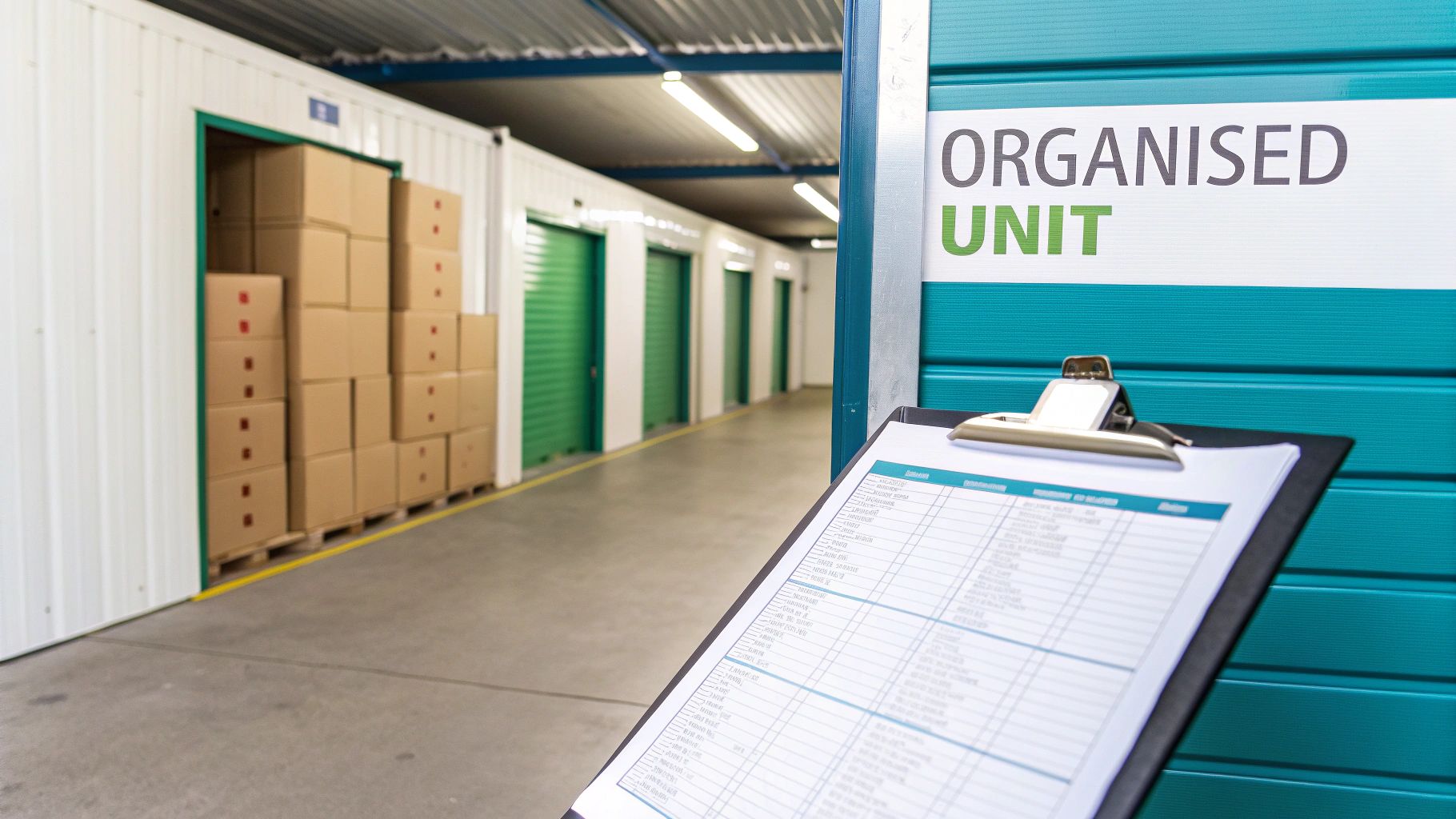
Simply moving everything into your office storage unit is only half the job. A disorganised unit can quickly become a chaotic, frustrating space where finding what you need feels like an impossible task. Real efficiency comes from a smart approach to organisation, turning your unit into a functional and accessible extension of your workspace.
An organised storage space saves valuable time and stops the accidental damage that often happens in a cluttered environment. The goal is to create a system where you can retrieve any item—from a single archive box to a specific piece of furniture—with minimal fuss. This process starts long before you even think about loading the van.
Planning Your Layout for Maximum Efficiency
The first step is to map out your unit’s layout. Think of it like a mini-warehouse. Your top priority should be a clear central aisle running from the door to the back wall. This simple walkway ensures no box or item is ever completely blocked in, saving you the headache of emptying half the unit just to reach something at the back.
Place larger, heavier items like desks and filing cabinets against the walls, keeping the centre free. You should also think about how often you'll need certain items. Files or stock you need regularly should be positioned near the entrance for a quick grab, while long-term archives can be tucked away further back.
A well-planned layout is the foundation of an efficient storage unit. A central aisle might seem like you’re sacrificing space, but the accessibility it provides will save you countless hours of frustration down the line.
The Art of Stacking and Boxing
How you pack and stack your items is crucial for both safety and making the most of your space. Investing in uniform, sturdy boxes is one of the smartest moves you can make. While grabbing mismatched, free boxes might seem like a good way to save money, they're often flimsy, hard to stack, and can collapse under weight, potentially damaging whatever is inside.
Here are a few best practices for boxing and stacking:
- Use Uniform Boxes: High-quality, same-sized boxes are designed to stack securely, letting you use the full vertical height of your unit without risk.
- Don't Overpack: Keep box weights manageable, around 15-20kg at most. Overly heavy boxes are not only a safety risk but are also more likely to break.
- Fill Empty Space: Use packing paper or bubble wrap to fill gaps inside boxes. This stops items from shifting around during transport and prevents the boxes from crushing when stacked.
- Heavy at the Bottom, Light at the Top: Always place the heaviest boxes at the base of a stack to create a stable foundation. Lighter items and more fragile contents should always go on top.
For a deeper dive into making the most of your space, our guide offers 5 essential tips for maximising business storage space that can help you get started.
Creating an Inventory and Labelling System
An organised unit is useless if you don’t know what's inside it. For any business using storage units for office needs, a detailed inventory list is non-negotiable. This doesn't need to be complicated; a simple spreadsheet will do the trick.
Your inventory should detail the contents of every single box. Assign each box a unique number and log it on your master list. This creates a searchable database, so when you need the 2022 financial records, you can quickly see they are in box #42.
Effective labelling is the final piece of the puzzle. Don't just scribble a label on the top of the box—you won't be able to see it once it's in a stack.
Follow this simple labelling method:
- Be Specific: Instead of "Office Supplies," write "A4 Printer Paper, Branded Pens, Staplers." The more detail, the better.
- Label Multiple Sides: Clearly label at least two adjacent sides of every box. This ensures you can identify the contents no matter how it’s stacked.
- Include the Box Number: Add the unique number from your master inventory list to each label for easy cross-referencing.
By combining a smart layout with disciplined packing and a clear inventory system, you’ll transform your storage unit from a simple dumping ground into a powerful organisational asset for your business.
How Storage Supports E-commerce and Home Offices
Self-storage has changed dramatically over the last few years. What was once a simple solution for stashing away old files has become a vital tool for two of the biggest shifts in business: the e-commerce explosion and the rise of the professional home office. These modern, agile ways of working need flexible, scalable, and affordable space that traditional commercial property just can't offer.
For online retailers, storage units for office use are a game-changer. They act as cost-effective micro-fulfilment centres, offering a nimble alternative to the long-term leases and hefty overheads of a traditional warehouse. An e-commerce business can kick off with a small unit for its first batch of stock and easily scale up to a larger space as sales take off, all without the financial handcuffs of a permanent warehouse. This agility is exactly what's needed to manage seasonal demand or test out new products.
Fuelling the E-commerce Engine
An e-commerce business using a storage unit can create a surprisingly efficient workflow. It becomes a secure, central hub for everything—receiving deliveries from suppliers, organising inventory, and packing up orders ready for dispatch. With features like extended access hours, business owners can run their operations on their own schedule, whether that's first thing in the morning or late at night.
- Stock Management: Keep inventory neat and accessible, preventing your home or small office from turning into a warehouse.
- Order Fulfilment: Set up a dedicated packing station to process orders without any fuss.
- Scalable Space: Easily upgrade or downsize your unit based on stock levels and seasonal peaks.
Empowering the Professional Home Office
At the same time, the surge in remote working has completely redefined the need for business storage. A home office can quickly get swamped with work equipment, product samples, marketing materials, and archived documents. This is where storage units for office provide a much-needed release valve, helping remote professionals reclaim their living space and keep a clear line between home and work life.
This growing need is showing up in market trends. The UK's office storage and organisational products market is set to hit £1.2 billion by 2033, partly fuelled by the demands of home-based businesses and the unstoppable growth of e-commerce. You can find more details on these trends over at Deep Market Insights.
A secure off-site unit acts as a professional annexe to a home office. It’s the perfect solution for storing sensitive documents, valuable equipment, or business stock without compromising on space or security at home.
By offering a secure, accessible, and affordable space, modern storage facilities provide the essential backbone that allows both new e-commerce brands and established home-based professionals to thrive. They're no longer just a place to store stuff, but a strategic tool for business growth and organisation.
Frequently Asked Questions About Office Storage
When you're looking into storage units for office use, a few questions always seem to pop up. To help you get the answers you need and make a confident decision, we’ve tackled some of the most common queries we hear from UK businesses.
Getting these details right from the start means you’ll end up with a storage solution that’s safe, compliant, and a perfect fit for your business. It’s all about avoiding the common slip-ups and making sure your off-site storage works for you from day one.
What Can I Not Store in a Business Storage Unit?
For everyone's safety and to stay on the right side of the law, every storage facility has strict rules on what you can and can't keep in your unit. It's vital to know these limitations to avoid breaking your rental agreement.
Typically, the no-go list includes:
- Perishable Goods: Any food items that can spoil, attract pests, or create bad odours are off-limits.
- Hazardous Materials: Think flammable liquids, chemicals, explosives, or anything else considered dangerous.
- Illegal Items: This covers any illegal substances, stolen goods, or counterfeit products.
- Living Things: It goes without saying, but you can’t store plants or animals in a storage unit.
Always double-check the specific policy of the storage provider you choose. Storing prohibited items can lead to your contract being terminated immediately, and you could face legal trouble.
Is Special Insurance Required for My Stored Items?
Yes, you'll almost certainly need insurance. While the facility’s own insurance covers the building, it’s up to you to insure the contents of your unit. This is what protects your business assets against things like fire, theft, or water damage.
Many storage providers offer their own specialised insurance plans, which are designed specifically for self-storage. Another option is to see if your existing business insurance policy can be extended to cover goods stored off-site. Before you sign anything, make sure you understand the facility's requirements and that your cover is enough to replace the full value of your items.
Can I Have Business Deliveries Sent to My Storage Unit?
Absolutely, and it’s a game-changer for many businesses. Lots of modern facilities that work with commercial clients offer a delivery acceptance service. This is incredibly useful for e-commerce businesses or any company that needs to receive stock without having someone on-site to sign for it.
The facility staff can accept deliveries for you and then place them securely in your unit or a designated holding area. It’s a key feature that helps businesses stay agile. Just be sure to confirm if this service is available and ask about any procedures or extra costs before you sign up.
Ready to secure a flexible, safe, and affordable space for your business assets? At Shield Self Storage, we provide premium storage units with robust security and convenient access. Get your fast, no-obligation quote today!

